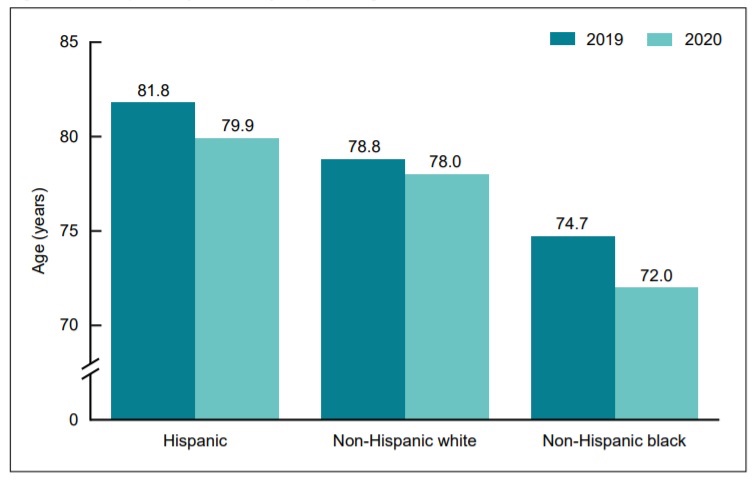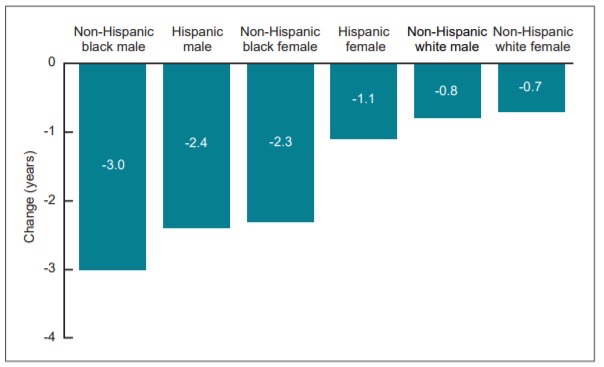The Chronicles Of Grant County
Life Expectancy
 This image shows estimated decreases in life expectancies among Hispanic Americans, Non-Hispanic White Americans, and Non-Hispanic Black Americans from Year 2019 to Year 2020 within the United States. Hispanic Americans live longer than both Non-Hispanic White Americans and Non-Hispanic Black Americans. Please note that these estimates are not final. According to the source of this image, the National Vital Statistics System of the National Center for Health Statistics, "estimates are based on provisional data from January 2020 through June 2020."
This image shows estimated decreases in life expectancies among Hispanic Americans, Non-Hispanic White Americans, and Non-Hispanic Black Americans from Year 2019 to Year 2020 within the United States. Hispanic Americans live longer than both Non-Hispanic White Americans and Non-Hispanic Black Americans. Please note that these estimates are not final. According to the source of this image, the National Vital Statistics System of the National Center for Health Statistics, "estimates are based on provisional data from January 2020 through June 2020."
Last year, on March 4, 2020, The Chronicles Of Grant County reported that "…there is now a looming influenza that may or may not have substantial impact in the United States. As of today, there are no definitive statistics on key facets of COVID-19, the new coronavirus. Scientists do not yet have firm details on the extent of the spread of this virus as well as its mortality rate. Leaders have confirmed that someone could have COVID-19, show no symptoms of the disease, and be contagious to others."
Two documents were released this month that provide some initial answers.
Life expectancy is likely lower today in the United States. This is likely because of both direct and indirect impacts of the COVID-19 Pandemic. People dying earlier than anticipated because of COVID-19 disease as well as people dying earlier than expected due to the lack of medical treatment for other diseases and other underlying conditions.
According to these two documents, the life expectancy is likely less for two major racial groups – White Americans and Black Americans – as well as for a major ethnic group – Hispanic Americans. Approximately half of the population in New Mexico includes Americans with Hispanic heritage.
These two documents make no mention of life expectancy of Asian Americans or Native Americans. According to the United States Census Bureau, there are estimated to be more than 22.8 million Americans with Asian heritage in our country as of 2019. The same report from the U S Census Bureau indicated that in 2019, there were estimated to be more than 1.6 million Americans with Native Hawaiian and Other Pacific Islander heritage in the United States as well as an estimated more than 6.9 million Americans with American Indian and Alaska Native heritage.
The impact on life expectancy for these 30 million Americans is unknown, thus far.
Please note that these 30 million Americans include an estimated 315,000 Native Americans and Asian Americans that live in New Mexico. According to the U S Census Bureau, there were estimated to be more than 255,000 Americans with Native American heritage as well as an estimated more than 59,000 Americans with Asian and Pacific Islander heritage living in New Mexico in 2019. Together, these Americans constitute an estimated 15% of the 2.1 million people who live in the State.
"Between 2019 and the first half of 2020, life expectancy decreased 2.7 years for the Non-Hispanic Black population (74.7 [years] to 72.0 [years])…It decreased by 1.9 years for the Hispanic population (81.8 [years] to 79.9 [years]) and by 0.8 year
for the Non-Hispanic White population," according to the report entitled "Provisional Life Expectancy Estimates for January through June, 2020." Non-Hispanic Black males, according to this report, saw their estimated life expectancy reduced by three years. This report was issued by the Federal government through the National Center for Health Statistics using information collected through its National Vital Statistics System.
"The provisional life expectancy estimates presented in this report are subject to important limitations," noted the authors of this report. "First, they are based on deaths that occurred during the first 6 months of the year [Year 2020] and do not reflect the entirety of the effects of the COVID-19 Pandemic in 2020, or other changes in causes of death, such as the increases in provisional drug overdose deaths through early 2020." The authors noted other limitations related to the "seasonality in death patterns in any given year" as well as the effects of the COVID-19 Pandemic in different geographic areas. "As a result," the report noted, "life expectancy at birth for the first half of 2020 may be underestimated since the
populations more severely affected, Hispanic and Non-Hispanic Black populations, are more likely to live in urban areas."
You can read this report by clicking here.
These life expectancy estimates are slightly different from estimates included in a research article released earlier this month. On February 2, 2021, the National Academy of Sciences released a research article detailing the impact of the COVID-19 Pandemic on life expectancy. The estimates in this research article were prepared by researchers from Princeton University and the University of Southern California using information that was available prior to July 15, 2020.
"We estimate life expectancy at birth and at age 65 years for 2020, for the total U S population and by race and ethnicity, using four scenarios of deaths – one in which the COVID-19 Pandemic had not occurred and three including COVID-19 mortality projections produced by the Institute for Health Metrics and Evaluation," the research article stated. "Our medium estimate indicates a reduction in U S life expectancy at birth of 1.13 years to 77.48 years, lower than any year since 2003. We also project a 0.87-year reduction in life expectancy at age 65 years. The Black and Latino populations are estimated to experience declines in life expectancy at birth of 2.10 and 3.05 years, respectively, both of which are several times the 0.68-year reduction for Whites. These projections imply an increase of nearly 40% in the Black – White life expectancy gap, from 3.6 years to…[more than] 5 years, thereby eliminating progress made in reducing this differential since 2006. Latinos, who have consistently experienced lower mortality than Whites (a phenomenon known as the Latino or Hispanic paradox), would see their more than 3-year survival advantage reduced to less than 1 year."
You can read this research article by clicking here.
To provide some perspective, the U S Census Bureau reported that life expectancy was estimated to be 70.1 years overall in the United States in 1960. At that time, the United States was ranked at 20th in life expectancy in the world; Ireland and Latvia had similar life expectancy rates overall at that time. Four countries in Europe – Iceland, Sweden, Norway, and the Netherlands – had the highest life expectancy rate overall in the world at 73.5 years in 1960.
The U S Census Bureau reported that life expectancy was estimated to be 78.9 years overall in the United States in 2015. At that time, the United States was ranked at 40th in life expectancy in the world; Lebanon had a similar life expectancy rate overall at that time. Japan had the highest life expectancy overall in the world at 83.3 years in 2015.
The Chronicles Of Grant County reported on March 4, 2020, that the impact of the Pandemic of 1918-1919 was much worse. The United States National Archives and Records Administration reported that "in one year, the average life expectancy in the United States dropped by 12 years." The United States Centers for Disease Control and Prevention reported that the virus that caused the Pandemic of 1918-1919 continued "to circulate seasonally for 38 years."
The eventual impact of the COVID-19 Pandemic remains to be seen.
While these reports did not consider Native Americans and Asian Americans to be important enough to consider when issuing these documents on life expectancy, the next issue of The Chronicles Of Grant County will be looking at how the COVID-19 Pandemic has affected all Americans, including those with Native American heritage and Asian American heritage.
 This image shows estimated decreases in life expectancies among certain racial, ethnic, and gender groups from Year 2019 to Year 2020 within the United States. Please note that these estimates are not final. According to the source of this image, the National Vital Statistics System of the National Center for Health Statistics, "estimates are based on provisional data from January 2020 through June 2020."
This image shows estimated decreases in life expectancies among certain racial, ethnic, and gender groups from Year 2019 to Year 2020 within the United States. Please note that these estimates are not final. According to the source of this image, the National Vital Statistics System of the National Center for Health Statistics, "estimates are based on provisional data from January 2020 through June 2020."
Do you have questions about communities in Grant County?
A street name? A building?
Your questions may be used in a future news column.
Contact Richard McDonough at chroniclesofgrantcounty@mail.com.
If your email does not go through, please contact editor@grantcountybeat.com.
© 2021 Richard McDonough


